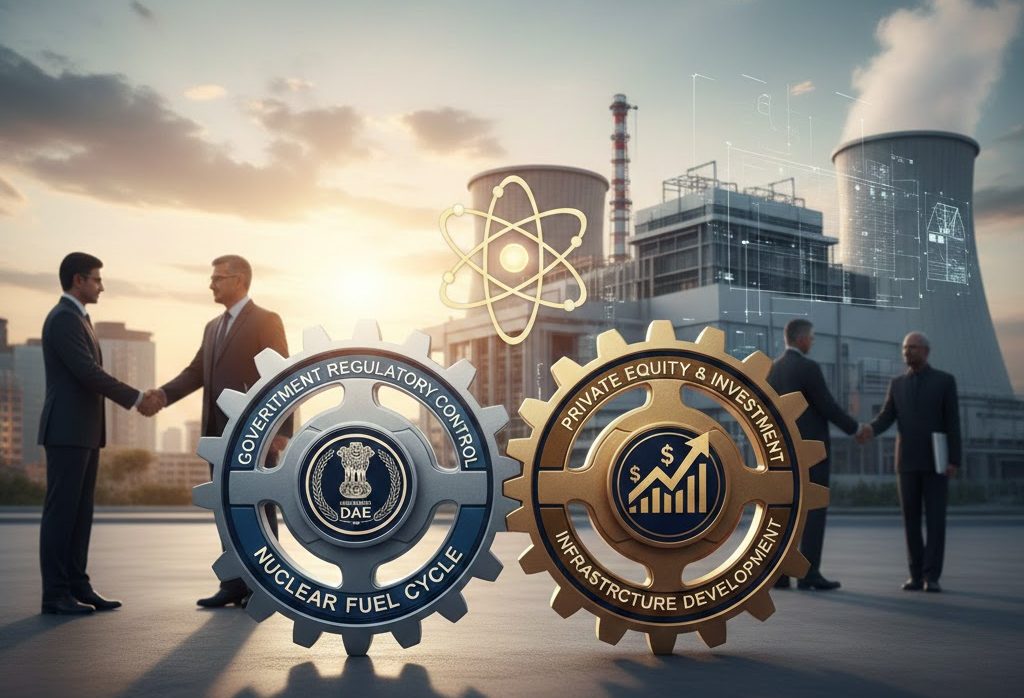Font size:
Print
Nuclear Energy: The New Powerhouse for a Digital World
Source of clean power or controversy?
Context: As global information technology (IT) operations race ahead — powered by AI, cloud computing, big data, and 24×7 hyperscale data centres — the demand for stable, high-density, low-emission energy has reached a critical point. The solution, increasingly, seems to be pointing toward a familiar yet controversial source: nuclear power.
More on News
- Microsoft has partnered with Constellation Energy to revive the Three Mile Island nuclear plant in Pennsylvania by 2028, committing to use its full power output for 20 years.
- Bill Gates has invested $1 billion in TerraPower, a developer of small modular reactors (SMRs), in collaboration with Warren Buffett’s PacifiCorp.
- Google is working with Kairos Power and has agreed to purchase all its nuclear power once production starts in 2030.
- Amazon is investing in X-Energy, another SMR company.
Fusion vs Fission: The Science Behind the Power
- Nuclear energy is generated via:
- Fission — where heavy atoms like uranium split to release energy (common today).
- Fusion — combining light atoms like hydrogen for even greater energy output, but still in experimental stages.
- While fusion offers safety and minimal waste, it remains a technological challenge — often described as the “holy grail” of clean energy.
Why Nuclear, Why Now?
- Nuclear energy offers several advantages over renewables:
- Consistent power supply — unaffected by weather or daylight.
- Low greenhouse gas emissions — making it climate-friendly.
- High energy density — small amounts of fuel generate large outputs.
- Compact land use — in contrast to sprawling solar and wind installations.
- For the tech sector, where uptime, cooling, and processing needs are relentless, these attributes are vital. Hyperscale data centres and AI infrastructure require constant, reliable power — a promise that solar and wind, despite their growth, can’t always fulfil.
India’s Nuclear Push: Bharat Reactors & Energy Security
- Nuclear Mission announced as part of the Union Budget 2025–26 marks a paradigm shift in India’s energy strategy. Nuclear power is identified as a key driver of India’s long-term energy security and clean energy transition.
- The government has set an ambitious target of 100 GW nuclear power capacity by 2047, aiming to reduce dependence on fossil fuels and ensure a stable energy supply.
- Bharat Reactors and Nuclear Energy Initiatives:
- Bharat Small Reactors (BSRs): These are 220 MW Pressurised Heavy Water Reactors (PHWRs) with a proven safety record.
- They are being modified to reduce land requirements, making them ideal for deployment near industries such as steel, aluminium, and metals, serving as captive power plants to aid in decarbonization.
- Bharat Small Modular Reactors (BSMRs): The government has allocated ₹20,000 crore for research and development of Small Modular Reactors (SMRs), targeting at least five indigenously designed operational SMRs by 2033.
- Private Sector Participation: The nuclear sector has been opened for private investment, with companies providing land, water, and capital, while Nuclear Power Corporation of India Limited (NPCIL) manages design and operation.
- Bharat Small Reactors (BSRs): These are 220 MW Pressurised Heavy Water Reactors (PHWRs) with a proven safety record.
Need for Nuclear Energy in Enhancing Energy Security
- Reliable Power Supply: Nuclear energy provides a stable and continuous power source, unlike renewables that depend on weather conditions.
- Reduced Carbon Emissions: Expanding nuclear power aligns with India’s commitment to clean energy, supporting the goal of 500 GW non-fossil fuel energy by 2030.
- Energy Independence: With India’s reliance on petroleum imports, nuclear energy can significantly reduce dependency on foreign energy sources.
- Industrial Growth: Bharat Reactors will support industries by providing captive power, ensuring uninterrupted energy supply for manufacturing and production.
Beyond Tech: A Multi-Sector Solution
- Electric vehicle (EV) infrastructure: Nuclear power can supply clean energy to charging stations.
- Heavy industry: High-temperature reactors can support steel, chemical, and cement production.
- Desalination: Nuclear heat can power seawater purification systems.
- Medical field: Radioisotopes from nuclear processes are critical for diagnostics and cancer treatment.
- Scientific research: Nuclear energy supports particle physics experiments.
- Space exploration: Missions to remote planets depend on radioisotope thermoelectric generators.
Key Milestones and Recent Developments
- RAPP-7 (Rajasthan) achieved criticality on September 19, 2024 – showcasing India’s indigenous reactor capability.
- Kakrapar KAPS-3 & 4 (700 MWe) began commercial operation in FY 2023–24.
- Jaduguda uranium mine discovered new deposits, extending its life by over 50 years.
- Prototype Fast Breeder Reactor (PFBR, 500 MWe) achieved major commissioning milestones in 2024.
- ASHVINI JV (NPCIL + NTPC) established to develop nuclear projects under the Atomic Energy Act.
The Challenges: Cost, Controversy, and Public Fear
- Despite its promise, nuclear energy remains a paradox — the cleanest path to power, yet the most radioactive road to controversy.
- Key challenges include:
- High upfront costs and long timelines due to complex tech and stringent regulations.
- Public perception is still shaped by the disasters at Chernobyl, Three Mile Island, and Fukushima — incidents involving meltdowns and radiation releases.
- Nuclear waste remains a thorny issue: highly toxic, long-lived, and expensive to manage. The U.S. currently stores used fuel at 70 sites across 35 states.
- To address this, the U.S. Department of Energy (DOE) is developing secure rail transport systems and government-owned waste storage facilities.
The Future: Small Modular Reactors and Global Competition
- The emergence of advanced microreactors and SMRs represents a more scalable, secure nuclear option:
- Microreactors: Factory-built, deployable in days, generate 1–10 MW (enough to power 1,000 homes for a decade).
- SMRs: Range from 10s to 100s of MW, with flexible configurations and lower proliferation risks.
- Over 40 countries are now pursuing nuclear expansion. By 2050, global nuclear energy capacity is expected to triple. Key players include:
- China, Russia, and the U.S. are all vying for technological dominance.
- India, where NTPC has invited global partners to localise pressured water reactors and help achieve a 100 GW nuclear power target.
- A major policy shift in India is the amendment of laws to allow private sector participation, signalling a bold new era of nuclear energy development.


